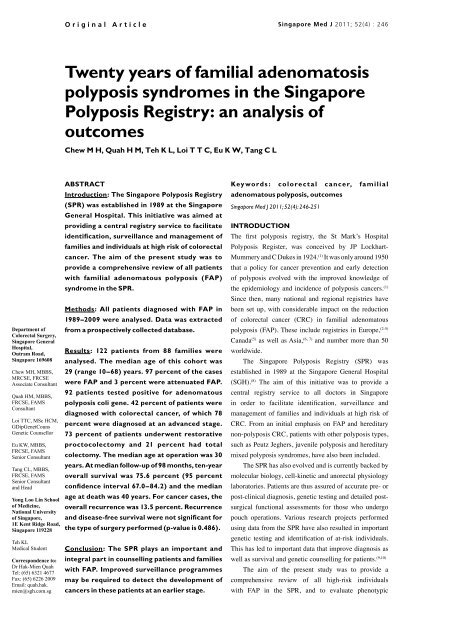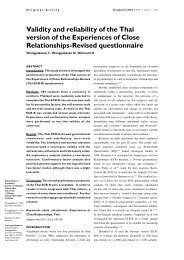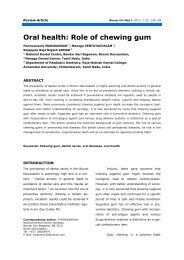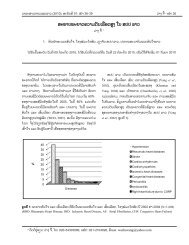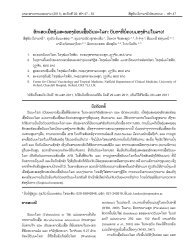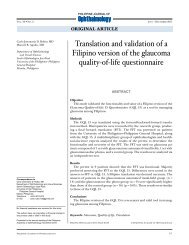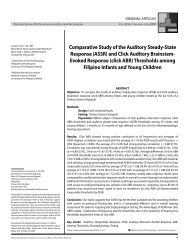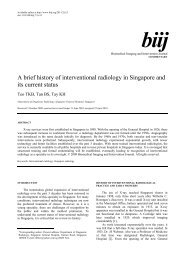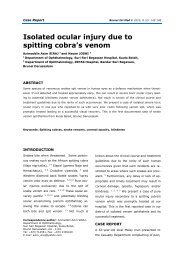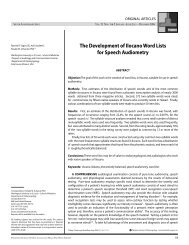PDF ( B) - APAMED Central
PDF ( B) - APAMED Central
PDF ( B) - APAMED Central
Create successful ePaper yourself
Turn your PDF publications into a flip-book with our unique Google optimized e-Paper software.
Original Article<br />
Singapore Med J 2011; 52(4) : 246<br />
Twenty years of familial adenomatosis<br />
polyposis syndromes in the Singapore<br />
Polyposis Registry: an analysis of<br />
outcomes<br />
Chew M H, Quah H M, Teh K L, Loi T T C, Eu K W, Tang C L<br />
Department of<br />
Colorectal Surgery,<br />
Singapore General<br />
Hospital,<br />
Outram Road,<br />
Singapore 169608<br />
Chew MH, MBBS,<br />
MRCSE, FRCSE<br />
Associate Consultant<br />
Quah HM, MBBS,<br />
FRCSE, FAMS<br />
Consultant<br />
Loi TTC, MSc HCM,<br />
GDipGenetCouns<br />
Genetic Counsellor<br />
Eu KW, MBBS,<br />
FRCSE, FAMS<br />
Senior Consultant<br />
Tang CL, MBBS,<br />
FRCSE, FAMS<br />
Senior Consultant<br />
and Head<br />
Yong Loo Lin School<br />
of Medicine,<br />
National University<br />
of Singapore,<br />
1E Kent Ridge Road,<br />
Singapore 119228<br />
Teh KL<br />
Medical Student<br />
Correspondence to:<br />
Dr Hak-Mien Quah<br />
Tel: (65) 6321 4677<br />
Fax: (65) 6226 2009<br />
Email: quah.hak.<br />
mien@sgh.com.sg<br />
ABSTRACT<br />
Introduction: The Singapore Polyposis Registry<br />
(SPR) was established in 1989 at the Singapore<br />
General Hospital. This initiative was aimed at<br />
providing a central registry service to facilitate<br />
identification, surveillance and management of<br />
families and individuals at high risk of colorectal<br />
cancer. The aim of the present study was to<br />
provide a comprehensive review of all patients<br />
with familial adenomatous polyposis (FAP)<br />
syndrome in the SPR.<br />
Methods: All patients diagnosed with FAP in<br />
1989–2009 were analysed. Data was extracted<br />
from a prospectively collected database.<br />
Results: 122 patients from 88 families were<br />
analysed. The median age of this cohort was<br />
29 (range 10–68) years. 97 percent of the cases<br />
were FAP and 3 percent were attenuated FAP.<br />
92 patients tested positive for adenomatous<br />
polyposis coli gene. 42 percent of patients were<br />
diagnosed with colorectal cancer, of which 78<br />
percent were diagnosed at an advanced stage.<br />
73 percent of patients underwent restorative<br />
proctocolectomy and 21 percent had total<br />
colectomy. The median age at operation was 30<br />
years. At median follow-up of 98 months, ten-year<br />
overall survival was 75.6 percent (95 percent<br />
confidence interval 67.0–84.2) and the median<br />
age at death was 40 years. For cancer cases, the<br />
overall recurrence was 13.5 percent. Recurrence<br />
and disease-free survival were not significant for<br />
the type of surgery performed (p-value is 0.486).<br />
Conclusion: The SPR plays an important and<br />
integral part in counselling patients and families<br />
with FAP. Improved surveillance programmes<br />
may be required to detect the development of<br />
cancers in these patients at an earlier stage.<br />
Keywords: colorectal cancer, familial<br />
adenomatous polyposis, outcomes<br />
Singapore Med J 2011; 52(4): 246-251<br />
Introduction<br />
The first polyposis registry, the St Mark’s Hospital<br />
Polyposis Register, was conceived by JP Lockhart-<br />
Mummery and C Dukes in 1924. (1) It was only around 1950<br />
that a policy for cancer prevention and early detection<br />
of polyposis evolved with the improved knowledge of<br />
the epidemiology and incidence of polyposis cancers. (1)<br />
Since then, many national and regional registries have<br />
been set up, with considerable impact on the reduction<br />
of colorectal cancer (CRC) in familial adenomatous<br />
polyposis (FAP). These include registries in Europe, (2-5)<br />
Canada (5) as well as Asia, (6, 7) and number more than 50<br />
worldwide.<br />
The Singapore Polyposis Registry (SPR) was<br />
established in 1989 at the Singapore General Hospital<br />
(SGH). (8) The aim of this initiative was to provide a<br />
central registry service to all doctors in Singapore<br />
in order to facilitate identification, surveillance and<br />
management of families and individuals at high risk of<br />
CRC. From an initial emphasis on FAP and hereditary<br />
non-polyposis CRC, patients with other polyposis types,<br />
such as Peutz Jeghers, juvenile polyposis and hereditary<br />
mixed polyposis syndromes, have also been included.<br />
The SPR has also evolved and is currently backed by<br />
molecular biology, cell-kinetic and anorectal physiology<br />
laboratories. Patients are thus assured of accurate pre- or<br />
post-clinical diagnosis, genetic testing and detailed postsurgical<br />
functional assessments for those who undergo<br />
pouch operations. Various research projects performed<br />
using data from the SPR have also resulted in important<br />
genetic testing and identification of at-risk individuals.<br />
This has led to important data that improve diagnosis as<br />
well as survival and genetic counselling for patients. (9,10)<br />
The aim of the present study was to provide a<br />
comprehensive review of all high-risk individuals<br />
with FAP in the SPR, and to evaluate phenotypic
Singapore Med J 2011; 52(4) : 247<br />
characteristics, surgical outcomes as well as survival<br />
data.<br />
Methods<br />
This study was approved by the Institutional Review<br />
Board of SGH. The records of all patients in the SPR<br />
have been prospectively collected in a computerised<br />
database. The clinical data from case records were<br />
obtained for analysis. FAP was diagnosed based on the<br />
clinical criteria of > 100 adenomas in the colon and<br />
rectum without family history, or in patients < 30 years of<br />
age with any number of adenomas and a positive family<br />
history of FAP. (11) Attenuated FAP (AFAP) is a distinctive<br />
phenotype that is recognised as a subset of FAP patients,<br />
and is defined in an individual who is characterised by a<br />
lower number of colorectal adenomas (< 100). (12) Patients<br />
with features that are suggestive of Gardner’s syndrome<br />
were classified as FAP. The cases in the registry were<br />
voluntarily registered by doctors who treated these<br />
patients across the country. Information was sought<br />
regarding the patients, and their family pedigrees were<br />
constructed based on detailed interviews conducted by<br />
the SPR coordinator. Histological data and reports were<br />
obtained whenever possible.<br />
As of December 2009, 88 families were registered<br />
with the SPR, comprising 524 patients and their firstdegree<br />
relatives. Complete histological reports were<br />
available for 122 patients, and these were investigated<br />
retrospectively. The rest of the patients’ histological<br />
reports were unavailable and thus not included in the<br />
analysis. Cases with unknown or incomplete data were<br />
excluded from the evaluation. Patients were divided<br />
into two time periods, 1989–1999 and 2000–2009, for<br />
analysis.<br />
The location of the index CRC was considered to be<br />
right-sided when it arose proximal to the splenic flexure,<br />
while lesions at or distal to the splenic flexure were<br />
deemed be left-sided. Synchronous CRC was defined<br />
as one found during the index operation for the CRC or<br />
diagnosed within 12 months after the resection of the<br />
index CRC. In the case of synchronous lesions, the most<br />
advanced lesion was used for comparison of tumour stage<br />
classification. The stage of disease was evaluated using<br />
plain chest radiograph, ultrasonography and/or computed<br />
tomography of the abdomen and pelvis. After surgical<br />
resection, pathologic staging of disease was based on the<br />
American Joint Committee on Cancer Staging Manual,<br />
6th edition, (13) with review of the resected specimen and<br />
investigations of distant metastases. Local recurrence<br />
was defined as the first clinically, radiologically and/or<br />
pathologically evident tumour of the same histological<br />
Table I. Demographics and clinicopathologic characteristics<br />
of the FAP cohort.<br />
Factor No. (%)<br />
Gender<br />
Male 73 (60)<br />
Female 49 (40)<br />
Ethnic group<br />
Chinese 84 (69)<br />
Malay 29 (23)<br />
Indian 7 (6)<br />
Others 2 (2)<br />
Median age; range (yrs)<br />
At diagnosis 29; 12–68<br />
At surgery 30;13–68<br />
≤ 40 97 (80)<br />
> 40 25 (20)<br />
Disease type<br />
FAP 118 (97)<br />
Attenuated FAP 4 (3)<br />
Mutation results<br />
Positive APC 92 (76)<br />
Negative APC 2 (2)<br />
Not done 28 (23)<br />
Cancer at diagnosis<br />
Yes 52 (43)<br />
No 70 (57)<br />
Site of tumour (n = 47)*<br />
Rectum 25 (53)<br />
Rectosigmoid 6 (13)<br />
Sigmoid 6 (13)<br />
Descending colon 3 (6)<br />
Transverse colon 3 (6)<br />
Ascending colon 3 (6)<br />
Caecum 1 (2)<br />
AJCC Stage (n = 52)<br />
I 6 (12)<br />
II 5 (10)<br />
III 31 (60)<br />
IV 10 (18)<br />
* Data is missing for 5 patients.<br />
FAP: familial adenomatous polyposis; APC: adenomatous<br />
polyposis coli; AJCC: American Joint Committee on Cancer<br />
type within or contiguous to the previously treated<br />
tumour bed. Distant recurrence was defined as similar<br />
evidence of spread outside the primary tumour site, at<br />
sites including but not limited to the liver, lungs, bone,<br />
brain and para-aortic region. Mortality data and the<br />
cause of death were obtained from the Singapore Cancer<br />
Registry.<br />
All statistical analyses were performed using the<br />
Statistical Package for the Social Sciences version 17.0<br />
(SPSS Inc, Chicago, IL, USA). For statistical significance<br />
analysis, Pearson’s chi-square test and Fisher’s exact test<br />
were used for comparison between groups. Continuous<br />
nonparametric data was analysed using the Mann<br />
Whitney U test. In the analysis of disease-free survival<br />
(DFS), a patient was considered to have an event if there<br />
was local or systemic recurrence after completion of the<br />
primary treatment. DFS was calculated from the date<br />
of surgery till the date of first recurrence. Patients with
Singapore Med J 2011; 52(4) : 248<br />
Table II. Types of extra-colonic manifestations.<br />
Type No. (%)<br />
Desmoids 16 (14)<br />
Abdominal wall 9<br />
Mesenteric 7<br />
Gastroduodenal polyps 36 (29)<br />
Cutaneous skin lumps 21 (17)<br />
Extra-colonic carcinomas 10 (8)<br />
Stomach 2<br />
Periampullary 1<br />
Thyroid 6<br />
Trachea SCC 1<br />
Table III. Types of surgical resection performed.<br />
Surgical resection No. (%)<br />
Cancer Prophylaxis<br />
(n = 52) (n = 70)<br />
Proctocolectomy and IPAA 37 (71) 52 (75)<br />
Total colectomy and IRA 8 (15) 18 (25)<br />
Others* 5 (10) -<br />
No operation 2 (4) -<br />
* Data includes 3 palliative resections, 1 loop colostomy and 1<br />
left hemicolectomy in a newly diagnosed case.<br />
IPAA: ileal pouch anal anastomosis; IRA: ileorectal anastomosis<br />
SCC: squamous cell carcinoma<br />
no evidence of disease after treatment were censored at<br />
the date of the last follow-up. Similarly, overall survival<br />
(OS) was computed from the date of surgery to the date<br />
when the patient was last known to be alive. The DFS<br />
and OS curves were constructed using the Kaplan-Meier<br />
method, and comparisons between groups of clinical<br />
interest were made using the log-rank test. Finally,<br />
multivariate Cox regression analysis was done to evaluate<br />
independent prognostic factors, adjusting for possible<br />
confounding factors. All statistical tests were assessed at<br />
the conventional 0.05 level of significance.<br />
Results<br />
Out of the 122 patients evaluated, 118 (97%) cases were<br />
FAP and four (3%) were AFAP. 60% of the study cohort<br />
(n = 73) were male and 40% (n = 49) were female. The<br />
main ethnic group of the patients was Chinese (n = 84,<br />
69%) followed by Malay (n = 29, 23%), reflecting the<br />
predominantly Chinese population in our country. The<br />
median age at diagnosis was 29 (range 13–68) years,<br />
while the median age at surgery was 30 (range 13–68)<br />
years. 97 (80%) patients had surgery before the age of<br />
40 years. Of the 94 patients who underwent adenomatous<br />
polyposis coli (APC) gene testing, 92 tested positive. 52<br />
(43%) patients presented with cancer at diagnosis, and<br />
the majority (n = 41, 78%) were advanced stage III and<br />
IV cancers (Table I). The most common site of cancers<br />
was the rectum (n = 25, 48%), and 11 (21%) patients<br />
had synchronous cancers. Interestingly, six out of the 11<br />
cases had synchronous lesions in the rectum as well.<br />
Extra-colonic manifestations are presented in Table<br />
II. The most common manifestations were stomach<br />
fundic gland polyps and duodenal adenomatous polyps<br />
(n = 36, 29%). Various cutaneous lumps, such as<br />
sebaceous cysts and osteomas, were found in 21 (17%)<br />
cases. Desmoids, located either in the abdominal wall<br />
(n = 9) or mesentery (n = 7), were found in 16 (14%)<br />
patients. Ten (8%) patients had extra-colonic cancers, of<br />
which thyroid cancers were the most common (n = 6).<br />
Of these ten patients, five had synchronous CRC. Dental<br />
abnormalities and congenital hypertrophy of the retinal<br />
pigment epithelium were not routinely evaluated in our<br />
patients.<br />
A comparison between surgery performed for<br />
CRC cases and that for prophylaxis was made (Table<br />
III). Overall, 89 (73%) patients underwent restorative<br />
proctocolectomy and 26 (21%) had total colectomy<br />
with ileorectal anastomosis (IRA). All ileal pouch anal<br />
anastomosis (IPAA) procedures were performed with<br />
the double stapling technique except for one case, for<br />
which mucosectomy and handsewn anastomosis were<br />
performed. For CRCs, 37 (71%) patients underwent<br />
restorative proctocolectomy, eight (15%) underwent total<br />
colectomies, three had palliative resection, one had loop<br />
colostomy and two did not undergo any operation in view<br />
of the advanced nature of the disease on presentation.<br />
One patient initially underwent a left hemicolectomy<br />
but subsequently had a total colectomy and anastomosis<br />
performed five years later for metachronous cancer.<br />
This was because the patient initially declined a radical<br />
colectomy, opting instead for a segmental colectomy<br />
despite adequate counselling.<br />
Comparative analysis was performed between<br />
the two periods, 1989–1999 (n = 76) and 2000–2009<br />
(n = 46). In 1989–1999, there were fewer cases of<br />
cancers at presentation (n = 30, 40%) but more total<br />
colectomies performed (n = 18, 24%) (IPAAs n = 54,<br />
71%). In the period 2000–2009, more cases of cancers<br />
were identified on presentation (n = 22, 48%) and more<br />
IPAAs were performed (n = 35, 76%) compared with<br />
total colectomies (n = 8, 17%). There was, however,<br />
no statistical significance in the surgical procedures<br />
performed between the two periods (p = 0.203).<br />
At the median follow-up of 98 months, the ten-year
Singapore Med J 2011; 52(4) : 249<br />
OS was 75.6% (95% confidence interval [CI] 67.0–84.2).<br />
82 (67%) patients were alive and had no disease. 33<br />
(27%) patients had died on review, 24 (20%) of whom<br />
died from CRC, seven (6%) from extra-colonic disease<br />
and two (1%) from other causes. The median age of death<br />
was 40 years. The overall five-year survival of patients<br />
with either CRC or extra-colonic cancer was 57.1% (95%<br />
CI 43.0–71.2) compared to 98.0% (95% CI 94.1–100.0)<br />
for those who had not developed cancer (Fig. 1). For<br />
cancer cases, the overall recurrence rate was 13.5% (n =<br />
7), of which four (7.7%) cases were distant metastasis and<br />
three (5.8%) were locoregional metastasis. Recurrence<br />
and DFS were not significantly different between IPAA<br />
and IRA (p = 0.486).<br />
Overall survival<br />
1.0<br />
0.8<br />
0.6<br />
0.4<br />
0.2<br />
FAP with<br />
cancer<br />
FAP without<br />
cancer<br />
FAP with<br />
cancer censored<br />
FAP without cancer<br />
FAP with cancer<br />
FAP without<br />
cancer censored<br />
Discussion<br />
FAP is an autosomal dominant multiorgan disease with<br />
variable expressivity. Inactivating mutations in the<br />
APC gene located on chromosome 5q21 (11) results in<br />
the characteristic development of multiple colorectal<br />
adenomatous polyps, which, without timely surgical<br />
intervention, would invariably develop into colorectal<br />
carcinoma in an individual by 35–40 years of age.<br />
FAP patients are also at risk of developing neoplasms<br />
in various tissues, such as osteomata of the jaw and<br />
skull bones, epidermoid cysts, congenital hypertrophy<br />
of the retinal pigment epithelium, dental anomalies,<br />
as well as gastric, duodenal, brain and desmoids<br />
tumours. These patients are noted to have a higher risk<br />
of developing brain tumours, papillary cancers of the<br />
thyroid and hepatoblastoma. (11,14,15)<br />
As a result of the autosomal dominant nature of this<br />
disease and the various phenotypes with which patients<br />
present, early diagnosis, treatment and careful followup<br />
of high-risk patients are essential. The development<br />
of FAP registries, in which pedigrees are constructed<br />
around an affected proband, is considered to be effective<br />
in structuring care for these patients and their families.<br />
Since its inauguration in 1989, the SPR has evolved into<br />
a service that is available to all doctors in Singapore<br />
in order to facilitate identification, surveillance and<br />
management of all FAP patients and their families. Its<br />
main objectives include the registration of all FAP<br />
families in Singapore so that at-risk individuals may be<br />
offered current screening procedures and treatments,<br />
as well as identification of family members for genetic<br />
testing and counselling services. The overall aim is to<br />
prevent the development of cancer in these high-risk<br />
patients. The workflow of the SPR is illustrated in Fig 2.<br />
The main benefits obtained from a detailed registry<br />
enable appropriate decisions to be made on the suitable<br />
0.0<br />
0 100 200 300 400<br />
Median follow-up (mths)<br />
Fig. 1 Comparison of survival between FAP patients with and<br />
without cancer (p < 0.0001).<br />
treatment for these young patients. It is paramount to<br />
provide the most appropriate treatment so as to reduce<br />
the risk of patients developing advanced CRC, and at the<br />
same time, ensuring that patients have the best possible<br />
quality of life. This is especially so for FAP patients who<br />
undergo radical surgery when they have no disabling<br />
clinical symptoms or only mild ones. The age of 30 years<br />
is a critical age for surgical prophylaxis, and colectomy<br />
should be offered from the age of 20 years. (6) This enables<br />
young patients to develop physically, grow in maturity in<br />
dealing with the disease as well as achieve educational<br />
and career milestones. These patients are thus able to<br />
complete crucial examinations or their tertiary/diploma<br />
education before undergoing surgery, which may take<br />
several months for complete recovery.<br />
The choice of surgery remains debatable. While<br />
IPAA was the most common procedure performed in<br />
our department, a relatively large number of IRAs were<br />
performed in both cancer cases and for prophylaxis.<br />
Restorative proctocolectomy was first described by Parks<br />
et al, (16) and was reported to eradicate all at-risk colorectal<br />
mucosa and maintain the anal canal with good functional<br />
results. IPAA thus appears to be the most appropriate<br />
procedure for FAP patients. IPAA is the procedure of<br />
choice in the presence of dysplasia in the rectum or<br />
rectal cancer. In our study cohort, the high incidence of<br />
rectal primary cancers (53%) and synchronous cancers in<br />
the rectum may suggest that IPAA should be advocated<br />
routinely in FAP patients. However, developing<br />
knowledge of the disease has suggested that IRA may be
Singapore Med J 2011; 52(4) : 250<br />
FAP notifications by physicians/medical practitioners/self-referral<br />
Check for duplications (family index)<br />
No<br />
Obtain family history<br />
Construction of pedigree<br />
Trace at-risk relatives<br />
Yes<br />
Data<br />
clarification<br />
Medical Records<br />
Office<br />
Department of<br />
Pathology<br />
Singapore Cancer<br />
Registry<br />
Offer screening to at-risk relatives<br />
Is screening offer accepted?<br />
No<br />
Monitor and follow up atrisk<br />
members<br />
Yes<br />
Refer to doctor<br />
for screening<br />
Update records<br />
Store to polyposis computer<br />
database system<br />
Fig. 2 Chart shows the workflow of the Singapore Polyposis Registry for FAP patients.<br />
a more suitable option in a select group of patients; the<br />
proposed criteria include clinical manifestations, social<br />
circumstances and the severity of genetic mutations. (17)<br />
Patients undergoing IRA may have an AFAP form of<br />
disease or fewer rectal polyps (usually recommended <<br />
20 polyps), and may thus be willing to undergo lifelong<br />
annual endoscopic surveillance. For genetic mutations,<br />
several reviews have identified the correlation between<br />
the clinical and genetic aspects, with preference for one<br />
surgical technique over another. Bulow et al identified<br />
patients with genetic errors in codon 0–200 or > 1,500,<br />
and proposed IRA over IPAA for these patients with mild<br />
genetic mutations. (18) The patients must, however, be<br />
compliant to surveillance.<br />
Patients’ wishes play an important part in the choice<br />
of procedure. The decision by a young patient is usually<br />
dependent on a family member’s experience (19) or<br />
information obtained from the internet. (20) They may thus<br />
be inclined to opt for or reject the same procedure that<br />
one of their family relatives had undergone, depending<br />
on the outcome experience. The lack of patientoriented<br />
information content on the internet also does<br />
not facilitate surgical decisions and may add to further<br />
decision dilemmas. (19) Furthermore, complications<br />
in IPAAs include a higher risk of night-time soilage,<br />
sexual and urinary dysfunction as well as a need for<br />
temporary defunctioning ileostomy. (21) These potentially<br />
embarrassing and distressing issues that may arise from<br />
an IPAA may dissuade the patient from opting for the<br />
procedure. This may require specially trained counselling<br />
methods.<br />
The surgical therapy for FAP is complex and patientcentric;<br />
hence, despite the suggested oncologic benefits<br />
of an IPAA, in carefully selected FAP patients, there<br />
may still be a role for IRA. As evident from our results,<br />
locoregional recurrence rates are low (5.7%) and there<br />
is no statistical significance in survival and recurrence<br />
between the type of surgery performed in both cancer<br />
and surgical prophylaxis cases. Likewise, this is observed<br />
in other registries and in a recent meta-analysis of 1,002<br />
patients from 12 studies, in which the risk of rectal cancer<br />
after IRA was reported to be 5.5%. (22) Meticulous followup<br />
is cited as one of the most important criteria if IRA is<br />
performed. (22,23) Iwama et al, who reviewed the data from<br />
the Japan Polyposis Registry where rectal-preserving<br />
operations are popular, cautioned that the cumulative risk<br />
of recurrence in the preserved rectum was 12% at ten<br />
years and 23% at 15 years. (6) This cumulative risk was<br />
also noted by other registries. (21,24) We still await longterm<br />
follow-up data in our own study cohort.<br />
Certain limitations are evident from this review.<br />
Difficulty in obtaining complete histological data from<br />
our registered FAP patients and the inability to perform<br />
surveillance and genetic testing in all patients are some<br />
of the limitations. This is due to the large number of<br />
migrant population in Singapore, with various family
Singapore Med J 2011; 52(4) : 251<br />
members residing in other countries. In addition, as<br />
the registration of patients by public and private sector<br />
physicians is voluntary, it is unlikely that all FAP patients<br />
in the country were captured. It is thus necessary to<br />
create greater awareness of the presence of the SPR in<br />
Singapore. Furthermore, it may not be possible for a<br />
physician or hospital to follow up on a patient for more<br />
than 20 years, as the patients are likely to move to other<br />
local hospitals for follow-up or migrate due to studies,<br />
work or marriage.<br />
In conclusion, clinical management of affected<br />
families in our registry has led to a good life expectancy<br />
for patients with FAP in our registry. In these highrisk<br />
individuals, early diagnosis and early appropriate<br />
prophylactic surgery are effective in preventing CRC.<br />
The choice of IPAA or IRA remains largely debatable,<br />
but as knowledge of the disease develops, better selection<br />
can be made to ensure good clinical outcome and low<br />
cancer recurrence. As our population continues to grow,<br />
there is an important need for the registry to train up more<br />
coordinators to educate FAP patients regarding the need<br />
for compliance to dedicated surveillance and follow-ups.<br />
In the long run, this would be crucial to further improving<br />
outcomes in FAP patients.<br />
Acknowledgements<br />
The authors would like to thank Dr Ming-Hian Kam, Dr<br />
Jit-Fong Lim, Dr Kheng-Hong Ng and Dr Kok-Sun Ho<br />
for their invaluable contributions to the study, and former<br />
Heads of Department of Colorectal Surgery, SGH, Dr<br />
Hak-Su Goh and Dr Seow-Choen Francis, for their<br />
vision and tireless commitment to the development of the<br />
Singapore Polyposis Registry.<br />
REFERENCES<br />
1. Bussey HJR. The St Mark’s Hospital Polyposis Registry. In:<br />
Contributions from St Mark’s Hospital. Sesquicentenary Volume<br />
1935-1985. Munich: Mann CV, 1988: 313-8.<br />
2. Bülow S. Results of national registration of familial adenomatous<br />
polyposis. Gut 2003; 52:742-6.<br />
3. Bertario L, Presciuttini S, Sala P, Rossetti C, Pietroiusti M.<br />
Causes of death and postsurgical survival in familial adenomatous<br />
polyposis: results from the Italian Registry. Italian Registry of<br />
Familial Polyposis Writing Committee. Semin Surg Oncol 1994;<br />
10:225-34.<br />
4. Heiskanen I, Luostarinen T, Järvinen HJ. Impact of screening<br />
examinations on survival in familial adenomatous polyposis.<br />
Scand J Gastroenterol 2000; 35:1284-7.<br />
5. Belchetz LA, Berk T, Bapat BV, Cohen Z, Gallinger S. Changing<br />
causes of mortality in patients with familial adenomatous<br />
polyposis. Dis Colon Rectum 1996; 39:384-7.<br />
6. Iwama T, Tamura K, Morita T, et al. Japanese Society for<br />
Cancer of the Colon and Rectum. A clinical overview of familial<br />
adenomatous polyposis derived from the database of the Polyposis<br />
Registry of Japan. Int J Clin Oncol 2004; 9:308-16.<br />
7. Ho JW, Chu KM, Tse CW, Yuen ST. Phenotype and management<br />
of patients with familial adenomatous polyposis in Hong Kong:<br />
perspective of the Hereditary Gastrointestinal Cancer Registry.<br />
Hong Kong Med J 2002; 8:342-7.<br />
8. Goh HS, Wong J. The Singapore Polyposis Registry. Ann Acad<br />
Med Singapore 1992; 21:290-3.<br />
9. Cao X, Eu KW, Seow-Choen F, Zao Y, Cheah PY. APC mutations<br />
and phenotypic spectrum of Singapore familial adenomatous<br />
polyposis patients. Eur J Hum Genet 2000; 8:42-8.<br />
10. Koh PK, Loi C, Cheah PY, et al. Mesenteric desmoids tumours<br />
in Singapore familial adenomatous polyposis patients: clinical<br />
course and genetic profile in a predominantly Chinese population.<br />
Dis Colon Rectum 2007; 50:75-82.<br />
11. Bussey HJR. Familial Polyposis Coli. John Hopkins University<br />
Press, Baltimore 1975:1-104.<br />
12. Knudsen AL, Bisgaard ML, Bülow S. Attenuated familial<br />
adenomatous polyposis (AFAP). A review of the literature. Fam<br />
Cancer 2003; 2:43-55.<br />
13. Greene FL, Page DL, Fleming ID, et al. AJCC Cancer Staging<br />
Manual. 6th Ed. New York: Springer-Verlag, 2002.<br />
14. Vasen HF, Möslein G, Alonso A, et al. Guidelines for the clinical<br />
management of familial adenomatous polyposis (FAP). Gut 2008;<br />
57:704-13.<br />
15. Vasen HF, BÜlow, The Leeds Castle Polyposis Group. Guidelines<br />
for the surveillance and management of familial adenomatous<br />
polyposis (FAP): a worldwide survey among 41 registries.<br />
Colorectal Dis 1999; 1:214-21.<br />
16. Parks AG, Nicholls RJ, Belliveau P. Proctocolectomy with ileal<br />
reservoir and anal anastomosis. Br J Surg 1980; 67:533-8.<br />
17. E. Contessini-Avesani E, Botti F, Negri C, et al. Familial<br />
Adenomatous polyposis. Surgical treatment: when and how. Tech<br />
Coloproctol 2004; 8:S309-14.<br />
18. Bulow C, Vasen H, Jarvinen H, Bjork J, Bisgaard ML, Bulow<br />
S. Ileorectal anastomosis is appropriate for a subset of patients<br />
with familial adenomatous polyposis. Gastroenterology 2000;<br />
119:1454-60.<br />
19. Neuman HB, Robbins L, Duarte J, et al. Risk-reducing surgery in<br />
FAP: role for surgeons beyond the incision. J Surg Oncol 2010;<br />
101:570-6.<br />
20. Neuman HB, Cabral C, Charlson ME, Temple LK. Is internet<br />
information adequate to facilitate surgical decision-making<br />
in familial adenomatous polyposis? Dis Colon Rectum 2007;<br />
50:2135-41.<br />
21. Bjork J, Akerbrant H, Iselius L, et al. Outcome of primary<br />
and secondary ileal pouch-anal anastomosis and ileorectal<br />
anastomosis in patients with FAP. Dis Colon Rectum 2001;<br />
44:984-92.<br />
22. Aziz O, Athanasiou T, Fazio VW, et al. Meta-analysis of<br />
observational studies of ileorectal versus ileal pouch-anal<br />
anastomosis for familial abdenomatous polyposis. Br J Surg 2006;<br />
93:407-17.<br />
23. Church J, Burke C, McGannon E, Pastean O, Clark B. Risk<br />
of rectal cancer in patients after colectomy and ileorectal<br />
anastomosis for familial adenomatous polyposis: a function of<br />
available surgical options. Dis Colon Rectum 2003; 46:1175-81.<br />
24. Campos FG, Imperiale AR, Seid VE, et al. Rectal and pouch<br />
recurrences after surgical treatment for familial adenomatous<br />
polyposis. J Gastrointest Surg 2009; 13:129-36.


